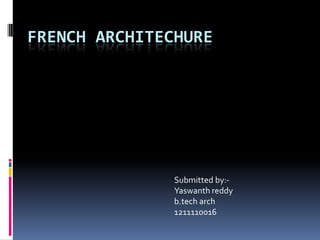This document provides an overview of various architectural styles that developed in France from Roman times to the Renaissance period. It discusses key characteristics of Roman, Romanesque, Gothic, Baroque, Rococo, Neoclassical and Renaissance architecture in France. Examples given include Notre Dame Cathedral (Gothic), Château de Chenonceau (Renaissance), Vaux-le-Vicomte and Palace of Versailles (Baroque). The document also summarizes the origins and influences of each style on architectural design in France.

















![Palais Garnier
The Palais Garnier (pronounced: [palɛ ɡaʁnje]; English: Garnier Palace) is a 1,979-seat opera
house, which was built from 1861 to 1875 for the Paris Opera. It was originally called the Salle des
Capucines because of its location on the Boulevard des Capucines in the 9th arrondissement of
Paris, but soon became known as the Palais Garnier in recognition of its opulence and its
architect, Charles Garnier.The theatre was also often referred to as the Opéra Garnier, the Opéra
de Paris or simply the Opéra. It was the primary home of the Paris Opera and its associated Paris
Opera Ballet until 1989, when a new 2,700-seat house, the Opéra Bastille, with elaborate facilities
for set and production changes, opened at the Place de la Bastille.The Paris Opera now mainly
uses the Palais Garnier for ballet.
The Palais Garnier is "probably the most famous opera house in the world, a symbol of Paris
like Notre Dame cathedral, theLouvre, or the Sacré Coeur basilica."This is at least partly due to its
use as the setting for Gaston Leroux's 1910 novel The Phantom of theOpera and the novel's
subsequent adaptations in films and Andrew LloydWebber's popular 1986 musical.Another
contributing factor is that among the buildings constructed in Paris during the Second
Empire, besides being the most expensive, it has been described as the only one that is
"unquestionably a masterpiece of the first rank."This opinion is far from unanimous however: the
20th-century French architect Le Corbusier once described it as "a lying art" and contended that
the "Garnier movement is a décor of the grave".](https://image.slidesharecdn.com/frencharchitechure-130909140519-/85/French-architechure-18-320.jpg)















